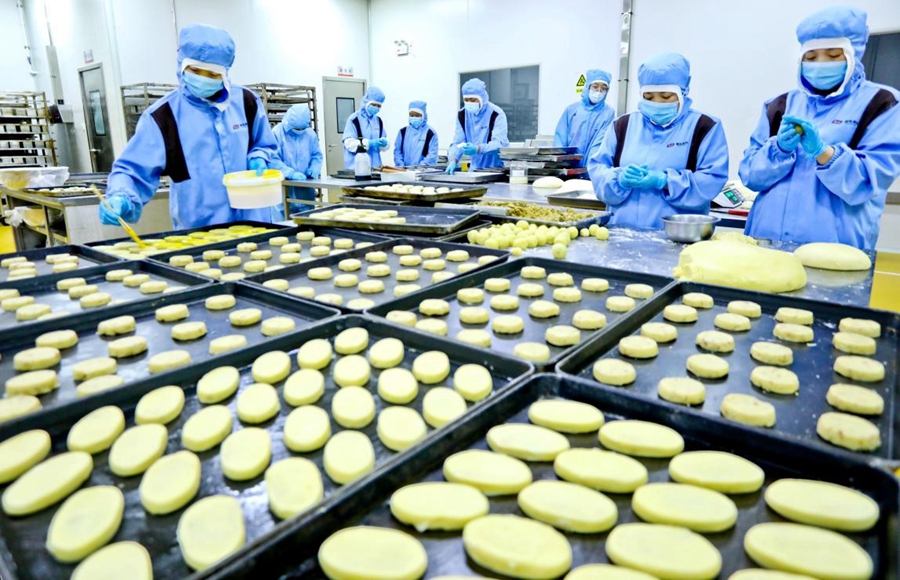China makes solid efforts to guarantee food safety
 |
| Cakes are being made in a workshop of a food enterprise in Zhangye, northwest China's Gansu province, July 29, 2021. (People's Daily Online/Wang Jiang) |
Food safety concerns the life and health of every one of us. Building better its food safety system and enhancing food safety regulation, China has constantly improved its capability to ensure the safety of foodstuffs at every link from farmland to the tables of the Chinese people.
As of this July, China had released 1,366 national standards on food safety that cover over 20,000 indexes. These standards set detailed specification on raw materials, supplements, appearance, nutrition, additives and microorganisms of food, offering fundamental institutional guarantee for food safety.
Last year, 2.31 percent of food products failed to meet safety standards in spot checks, which is basically equal to the figure in 2019. It indicated a stable momentum of growing food safety. Qualification rate of agricultural products have been maintained above 97 percent for six years in a row.
Relevant departments have further enhanced law enforcement in key fields and links concerning food security. In November 2020, the State Administration for Market Regulation, together with the Ministry of Agriculture and Rural Affairs and the Ministry of Public Security jointly launched a special law enforcement campaign to crack down on counterfeit food in rural areas. As of July 15, market regulation departments have dealt with 104,000 relevant illegal cases and seized 2,766 tonnes of illegal products. The law enforcement campaign has forcefully purified the rural food market.
On March 18 this year, the Ministry of Human Resources and Social Security, as well as the State Administration for Market Regulation and the National Bureau of Statistics unveiled 18 new professions, including food safety manager.
To ensure that food producers and business operators fulfill their responsibilities, local authorities in China are currently working on food traceability mechanisms that make the sources and distribution of food products traceable.
East China's Zhejiang province recently launched a closed-loop management system for food traceability, which monitors the whole industrial chain of food products from farmland to workshops and markets. Customers can learn the processing, quality check result and spot check result of food products by simply scanning the QR codes on product packages. Once problems are found, food regulation departments will locate merchants responsible with the traceability system so as to protect the rights and interests of customers.
Fujian province in southeast China has launched a traceability platform that is connected with traceability systems of agriculture and rural affairs department, ocean and fisheries department, market regulation department, customs, as well as enterprises, associations and third-party organizations. The platform is joined by 161,200 food producers and business operators.
To prevent possible risks of COVID-19 control brought by imported cold-chain products, China has set up a national traceability and management platform for imported cold-chain food, which is connected to data platforms of the country's 31 provincial level regions. By April this year, 13,896 tonnes of COVID-19 contaminated food had been discovered. It is reported that the State Administration for Market Regulation will guide local authorities to develop their own traceability systems, and weave a network of food traceability that covers the whole country.
New products, businesses and modes of the food industry also pose challenges for food regulation. China is employing big data, AI, Internet + and other information technologies to enhance its food safety regulation. For example, Shenzhen in south China's Guangdong province has largely promoted the construction of a smart monitoring and bulletin system for the catering industry. The city has installed over 60,000 surveillance cameras for more than 10,000 enterprises in the sector, and the cameras are connected to a command center of the market regulation department. Based on AI recognition and big data analysis, the cameras capture and verify common violations during food processing procedures. They also push rectification requirements to enterprises, and the latter would report their rectification results online. Meanwhile, consumers can check the qualifications, supervision, and spot check information about restaurants and review them by scanning QR codes.
 |
Photos
Related Stories
Copyright © 2021 People's Daily Online. All Rights Reserved.










